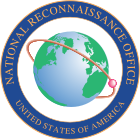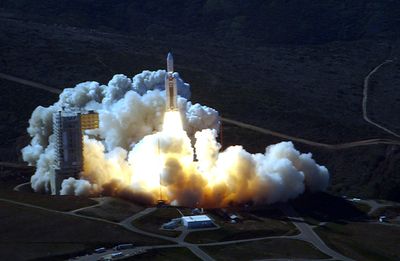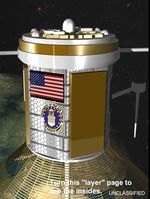National Reconnaissance Office
| National Reconnaissance Office | |
|---|---|
 |
|
| Agency overview | |
| Formed | 1961 |
| Headquarters | Chantilly, Virginia |
| Employees | Approximately 3,000[1] |
| Annual budget | Classified |
| Agency executives | Bruce A. Carlson, Director (DNRO) Betty J. Sapp, Principal Deputy Director (PDDNRO) Major General Susan K. Mashiko (USAF), Deputy Director (DDNRO) |
| Parent agency | Department of Defense |
| Website | |
| www.nro.gov | |
The National Reconnaissance Office (NRO), located in Chantilly, Virginia, is one of the 16 U.S. intelligence agencies. It designs, builds, and operates the spy satellites of the United States government.[2]
Contents |
Mission
The National Reconnaissance Office (NRO) develops and operates unique and innovative space reconnaissance systems and conducts intelligence-related activities essential for U.S. National Security.[3]
It also coordinates collection and analysis of information from airplane and satellite reconnaissance by the military services and the Central Intelligence Agency.[4] It is funded through the National Reconnaissance Program, which is part of the National Foreign Intelligence Program. The agency is part of the Department of Defense.
The NRO works closely with its intelligence and space partners, which include the National Security Agency (NSA), the National Geospatial-Intelligence Agency (NGA), the Central Intelligence Agency (CIA), the Defense Intelligence Agency (DIA), the United States Strategic Command, Naval Research Laboratory and other agencies and organizations.
It has been proposed that the NRO share imagery of the United States itself with the National Applications Office for domestic law enforcement.[5] The NRO operates ground stations around the world that collect and distribute intelligence gathered from reconnaissance satellites.
According to Asia Times Online, one important mission of NRO satellites is the tracking of non-US submarines on patrol or on training missions in the world's oceans and seas.[6]
History
The NRO was established on August 25, 1960, after management problems and insufficient progress with the USAF satellite reconnaissance program (see SAMOS and MIDAS).[7]:23[8] The formation was based on a 25 August 1960 recommendation to President Dwight D. Eisenhower during a special National Security Council meeting, and the agency was to coordinate the USAF and CIA's (and later the Navy and NSA's) reconnaissance activities.[7]:46
The NRO's first photo reconnaissance satellite program was the Corona program, the existence of which was declassified February 24, 1995, existed from August 1960 to May 1972, although the first test flight occurred on February 28, 1959. The Corona system used (sometimes multiple) film capsules dropped by satellites, which were recovered mid-air by military craft.
The first successful recovery from space (Discoverer XIII) occurred on August 12, 1960, and the first image from space was seen six days later. The first imaging resolution was 8 meters, which was improved to 2 meters. Individual images covered, on average, an area of about 10 by 120 miles (16 by 190 km). The last Corona mission (the 145th), was launched May 25, 1972, and this mission's last images were taken May 31, 1972.
From May 1962 to August 1964, the NRO conducted 12 mapping missions as part of the "Argon" system. Only seven were successful.
In 1963, the NRO conducted a mapping mission using higher resolution imagery, as part of the "Lanyard" program. The Lanyard program flew one successful mission.
NRO missions since 1972 are classified, and portions of many earlier programs remain unavailable to the public.
In 1985, a New York Times article exposed the existence and operations of the NRO.[9]
The existence of the NRO was declassified by the Deputy Secretary of Defense, as recommended by the Director of Central Intelligence on September 18, 1992.[10]
A Washington Post article in September 1995 reported that the NRO had quietly hoarded between $1 billion and $1.7 billion in unspent funds without informing the Central Intelligence Agency, the Pentagon, or Congress. The CIA was in the midst of an inquiry into the NRO's funding because of complaints that the agency had spent $300 million of hoarded funds from its classified budget to build a new headquarters building in Chantilly, Virginia a year earlier.
The presence of the classified new headquarters was revealed by the Federation of American Scientists who obtained unclassified copies of the blueprints filed with the building permit application. After 9/11 those blueprints were apparently classified. The reports of an NRO slush fund were true. According to former CIA general counsel Jeffrey Smith, who led the investigation: "Our inquiry revealed that the NRO had for years accumulated very substantial amounts as a 'rainy day fund.'"[11]
In 1999 the NRO embarked on a project with Boeing entitled Future Imagery Architecture to create a new generation of imaging satellites. In 2002 the project was far behind schedule and would most likely cost $2 billion to $3 billion more than planned, according to NRO records. The government pressed forward with efforts to complete the project, but after two more years, several more review panels and billions more in expenditures, the project was killed in what the Times report calls "perhaps the most spectacular and expensive failure in the 50-year history of American spy satellite projects."[12]
In what may have been a bizarre coincidence, NRO was planning an exercise on September 11, 2001, involving an accidental aircraft crash into one of its buildings. This has been cited by 9/11 conspiracy theorists as proof of their beliefs.[13] In charge of the exercise was CIA man John Fulton, head of the NRO's "Strategic War Gaming Division".[14] [See below.]
In January 2008, the government announced that a reconnaissance satellite operated by the NRO would make an unplanned and uncontrolled re-entry into the Earth's atmosphere in the next several months. Satellite watching hobbyists said that it was likely the USA-193, built by Lockheed Martin Corporation, which failed shortly after achieving orbit in December 2006.[15]
On February 14, 2008, the Pentagon announced that rather than allowing the satellite to make an uncontrolled re-entry, it would instead be shot down by a missile fired from a Navy cruiser.[16] The intercept took place on February 21, 2008.[17]
In July 2008, the NRO declassified the existence of its Synthetic Aperture Radar satellites, citing difficulty in discussing the creation of the Space-Based Radar with the United States Air Force and other entities.[18]
In August 2009, The Black Vault FOIA archive obtained a copy of the NRO video, "Satellite Reconnaissance: Secret Eyes in Space." [19] The 7 minute video chronicles the early days of the NRO and many of its early programs.
At the National Space Symposium in April 2010 NRO director General Bruce Carlson, USAF (Ret.) announced that till the end of 2011 NRO is embarking on "the most aggressive launch schedule that this organization has undertaken in the last twenty-five years. There are a number of very large and very critical reconnaissance satellites that will go into orbit in the next year to a year and a half."[20]
Organization
The NRO is part of the Department of Defense. The Director of the NRO is appointed by the Secretary of Defense with the consent of the Director of National Intelligence, without confirmation from Congress. Traditionally, the position was given to either the Undersecretary of the Air Force or the Assistant Secretary of the Air Force for Space, but with the appointment of Donald Kerr as Director of the NRO in July 2005 the position is now independent.
Personnel
The majority of the workers for the NRO are private corporate contractors, with $7 billion out of the agency's $8 billion budget going to private corporations.[21] The NRO is also staffed by personnel from the CIA, NSA, NGA, DIA, and the military services.
The Agency has the following directorates:- SIGINT Systems; Communications Systems; IMINT systems; and Advanced Systems and Technology.[22] (SIGINT=signals intelligence; IMINT=imagery intelligence.)
NRO Directives and Instructions
Under the Freedom of Information Act the NRO declassified a list of their secret directives for internal use. The following is a list of the released directives, which are available for download:
- NROD 10-2 - "National Reconnaissance Office External Management Policy"
- NROD 10-4 - "National Reconnaissance Office Sensitive Activities Management Group"
- NROD 10-5 - "Office of Corporate System Engineer Charter"
- NROD 22-1 - "Office of Inspector General"
- NROD 22-2 - "Employee Reports of Urgent Concerns to Congress"
- NROD 22-3 - "Obligations to report evidence of Possible Violations of Federal Criminal Law and Illegal Intelligence Activities"
- NROD 50-1 - "Executive Order 12333 - Intelligence Activities Affecting United States Persons"
- NROD 61-1 - "NRO Internet Policy, Information Technology"
- NROD 82-1a - "NRO Space Launch Management"
- NROD 110-2 - "National Reconnaissance Office Records and Information Management Program"
- NROD 120-1 - UNKNOWN, AWAITING FOIA RESPONSE
- NROD 120-2 - "The NRO Awards and Recognition Programs"
- NROD 120-3 - "Executive Secretarial Panel"
- NROD 120-4 - "National Reconnaissance Pioneer Recognition Program"
- NROD 120-5 - "National Reconnaissance Office Utilization of the Intergovernmental Personnel Act Mobility Program"
- NROD 121-1 - "Training of NRO Personnel"
- NROI 150-4 - "Prohibited Items in NRO Headquarters Buildings/Property"
"Strategic War Gaming Division"
According to a pamphlet advertising a security conference in 2002, the NRO has a "Strategic Wargaming Division", then headed by John Fulton, who was "on staff for the CIA".[23]
Spacecraft


The NRO spacecraft include:
- Keyhole series — photo imaging:
- KH-1, KH-2, KH-3, KH-4, KH-4A, KH-4B Corona (1959–1972)
- KH-5 — Argon (1961–1962)
- KH-6— Lanyard (1963)
- KH-7 — Gambit (1963–1967)[24]
- KH-8 — Gambit (1966–1984)
- KH-9 — Hexagon and Big Bird (1971–1986)
- KH-10 — Dorian (cancelled)
- KH-11 — Crystal and Kennan (1976–1988)
- KH-12 — Ikon and Improved Crystal (1990?–)
- KH-13 — (1999?)
- Samos — photo imaging (1960–1962)
- Poppy – ELINT program (1962–1971) continuing Naval Research Laboratory's GRAB (1960–1961)
- Jumpseat (1971–1983) and Trumpet (1994–1997) SIGINT
- Lacrosse/Onyx — radar imaging (1988–)
- Canyon (1968–1977), Vortex/Chalet (1978–1989) and Mercury (1994–1998)—SIGINT including COMINT
- Rhyolite/Aquacade (1970–1978), Magnum/Orion (1985–1990), and Mentor (1995–2003)—SIGINT
- Quasar, communications relay
- Misty/Zirconic – stealth IMINT
- NROL-1 through NROL-26 – various secret satellites. NROL stands for National Reconnaissance Office Launch.
Locations
In October 2008, NRO declassified five mission ground stations: three in the United States, near Washington, D.C.; Denver, Colorado; and Las Cruces, New Mexico, and a presence at RAF Menwith Hill and Pine Gap.
- NRO Headquarters - Chantilly, Virginia
- National Reconnaissance Operations Center (NROC) - ????
- Aerospace Data Facility, East
- Aerospace Data Facility, Colorado (Buckley)
- Aerospace Data Facility, Southwest[25]
Image gallery
|
NRO Organization, circa 1971 |
NRO Organization, circa 2009 |
National Reconnaissance Operations Center |
ADF-East Logo |
ADF-Southwest Logo |
|
ADF-Colorado Logo |
See also
- National Technical Means
- Reconnaissance satellite
References
- ↑ "NRO Factsheet" (Word Document). pp. 1. http://www.nro.gov/nro_factsheet.doc. Retrieved 2007-01-15.
- ↑ "Welcome to the NRO". http://www.nro.gov/index.html. Retrieved 2007-01-15.
- ↑ Center for the Study of National Reconnaissance: Bulletin, Combined 2002 Issue, pg 5
- ↑ "NRO Provides Support to the Warfighters", National Reconnaissance Office, press releases, April 28, 1998.
- ↑ "U.S. Reconnaissance Satellites: Domestic Targets - Documents Describe Use of Satellites in Support of Civil Agencies and Longstanding Controversy". National Security Archive, The George Washington University. 2008-04-11. http://www.gwu.edu/~nsarchiv/NSAEBB/NSAEBB229/index.htm. Retrieved 2008-04-12.
- ↑ Asia Times Online, "US Satellites Shadow China's Submarines", May 13, 2010.
- ↑ 7.0 7.1 Stares, Paul B.. "The Militarization of Space". p. p23,46. http://www.foreignaffairs.org/19851201fabook11624/paul-b-stares/the-militarization-of-space-u-s-policy-1945-1984.html. Retrieved 2008-11-24.
- ↑ Jeffrey Richelson (1990). America's Secret Eyes in Space. Harper & Row.
- ↑ Bamford, James (1985). "America's Supersecret Eyes In Space". The New York Times (New York: The New York Times). January 13, 1985. http://select.nytimes.com/search/restricted/article?res=F30D10F73D5F0C708DDDA80894DD484D81.
- ↑ Jeffrey T. Richelson (September 18, 2008). "Out of the Black: The Declassification of the NRO". National Security Archive Electronic Briefing Book No. 257. National Security Archive. http://www.gwu.edu/~nsarchiv/NSAEBB/NSAEBB257/index.htm. Retrieved 2008-10-13.
- ↑ "Get Smarter: Demystifying the NRO". SECRECY & GOVERNMENT BULLETIN, Issue Number 39. Federation of American Scientists. August-September 1994. http://www.fas.org/sgp/bulletin/sec39.html. Retrieved 2008-10-13.
- ↑ Philip Taubman (2007-11-11). "Failure to Launch: In Death of Spy Satellite Program, Lofty Plans and Unrealistic Bids". The New York Times. http://www.nytimes.com/2007/11/11/washington/11satellite.html?pagewanted=all#step1. Retrieved 2007-11-12.
- ↑ Coincidence of bomb exercises? - Channel 4 News
- ↑ John J. Lumpkin, Associated Press, "Agency planned exercise on September 11 built around a plane crashing into a building", Boston Chronicle, September 11, 2002.
- ↑ John Schwartz (2008-02-05). "Satellite Spotters Glimpse Secrets, and Tell Them". The New York Times. http://www.nytimes.com/2008/02/05/science/space/05spotters.html. Retrieved 2008-02-05.
- ↑ David Stout and Thom Shanker (2008-02-14). "U.S. Officials Say Broken Satellite Will Be Shot Down". The New York Times. http://www.nytimes.com/2008/02/14/science/14cnd-satellite.html?pagewanted=print. Retrieved 2008-02-14.
- ↑ U.S. Department of Defense (February 20, 2008). "DoD Succeeds In Intercepting Non-Functioning Satellite". Press release. http://www.defenselink.mil/releases/release.aspx?releaseid=11704. Retrieved 2008-02-20.
- ↑ Colin Clark (2008-07-03). "Spy Radar Satellites Declassified". DoD Buzz, through Military.com. http://www.dodbuzz.com/2008/07/03/spy-radar-satellites-declassified/. Retrieved 2008-07-10.
- ↑ The Black Vault, "Download the declassified Satellite Reconnaissance: Secret Eyes in Space", NRO, August 2009.
- ↑ Bruce Carlson (April 14, 2010). "Bruce Carlson, Director, NRO, National Space Symposium, Remarks". National Reconnaissance Office. http://www.nro.gov/speeches/DNRO_National_Space_Symposium.pdf. Retrieved 2010-06-04.
- ↑ Paglen, Trevor (February, 2009). "11". Blank Spots On the Map: The Dark Geography of the Pentagon's Secret World. New York: Dutton. pp. 176.
- ↑ :: Welcome to the National Reconnaissance Office::
- ↑ America's Leadership Challenge (pre-event publicity pamphlet for National Law Enforcement And Security Institute [NLSI] conference "Homeland Security: America's Leadership Challenge", September 6, 2002).
- ↑ Center for the Study of National Reconnaissance: Bulletin, Combined 2002 Issue: "Declassification of Early Satellite Reconnaissance Film"
- ↑ Mission Ground Station Declassification memo, 2008
External links
- NRO official website
- National Security Archive: The NRO Declassified
- Memo of Declassification of NRO
- Additional NRO information from the Federation of American Scientists
- America's secret spy satellites are costing you billions, but they can't even get off the launch pad U.S. News and World Report, 8/11/03; By Douglas Pasternak
- Agency planned exercise on September 11 built around a plane crashing into a building, from Boston.com
|
|||||||||||
|
|||||||||||||||||||||||||||||
|
|||||||||||||||||||||||||||||||||||||||||||||||
